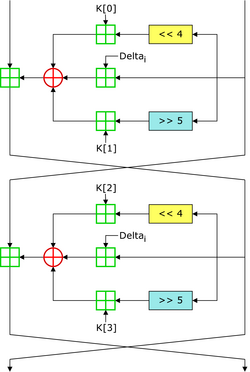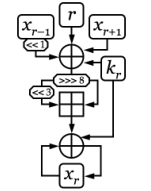In cryptography, a block cipher is a deterministic algorithm that operates on fixed-length groups of bits, called blocks. Block ciphers are the elementary building blocks of many cryptographic protocols. They are ubiquitous in the storage and exchange of data, where such data is secured and authenticated via encryption.
Differential cryptanalysis is a general form of cryptanalysis applicable primarily to block ciphers, but also to stream ciphers and cryptographic hash functions. In the broadest sense, it is the study of how differences in information input can affect the resultant difference at the output. In the case of a block cipher, it refers to a set of techniques for tracing differences through the network of transformation, discovering where the cipher exhibits non-random behavior, and exploiting such properties to recover the secret key.

In cryptography, an HMAC is a specific type of message authentication code (MAC) involving a cryptographic hash function and a secret cryptographic key. As with any MAC, it may be used to simultaneously verify both the data integrity and authenticity of a message. An HMAC is a type of keyed hash function that can also be used in a key derivation scheme or a key stretching scheme.

A cryptographic hash function (CHF) is a hash algorithm that has special properties desirable for a cryptographic application:

In cryptography, the Tiny Encryption Algorithm (TEA) is a block cipher notable for its simplicity of description and implementation, typically a few lines of code. It was designed by David Wheeler and Roger Needham of the Cambridge Computer Laboratory; it was first presented at the Fast Software Encryption workshop in Leuven in 1994, and first published in the proceedings of that workshop.
In computer science and cryptography, Whirlpool is a cryptographic hash function. It was designed by Vincent Rijmen and Paulo S. L. M. Barreto, who first described it in 2000.

The MD4 Message-Digest Algorithm is a cryptographic hash function developed by Ronald Rivest in 1990. The digest length is 128 bits. The algorithm has influenced later designs, such as the MD5, SHA-1 and RIPEMD algorithms. The initialism "MD" stands for "Message Digest".
Lars Ramkilde Knudsen is a Danish researcher in cryptography, particularly interested in the design and analysis of block ciphers, hash functions and message authentication codes (MACs).
In cryptography, N-hash is a cryptographic hash function based on the FEAL round function, and is now considered insecure. It was proposed in 1990 in an article by Miyaguchi, Ohta, and Iwata; weaknesses were published the following year.
The MD2 Message-Digest Algorithm is a cryptographic hash function developed by Ronald Rivest in 1989. The algorithm is optimized for 8-bit computers. MD2 is specified in IETF RFC 1319. The "MD" in MD2 stands for "Message Digest".
Bart Preneel is a Belgian cryptographer and cryptanalyst. He is a professor at Katholieke Universiteit Leuven, in the COSIC group.
FORK-256 is a hash algorithm designed in response to security issues discovered in the earlier SHA-1 and MD5 algorithms. After substantial cryptanalysis, the algorithm is considered broken.

RadioGatún is a cryptographic hash primitive created by Guido Bertoni, Joan Daemen, Michaël Peeters, and Gilles Van Assche. It was first publicly presented at the NIST Second Cryptographic Hash Workshop, held in Santa Barbara, California, on August 24–25, 2006, as part of the NIST hash function competition. The same team that developed RadioGatún went on to make considerable revisions to this cryptographic primitive, leading to the Keccak SHA-3 algorithm.

Cryptography, or cryptology, is the practice and study of techniques for secure communication in the presence of adversarial behavior. More generally, cryptography is about constructing and analyzing protocols that prevent third parties or the public from reading private messages. Modern cryptography exists at the intersection of the disciplines of mathematics, computer science, information security, electrical engineering, digital signal processing, physics, and others. Core concepts related to information security are also central to cryptography. Practical applications of cryptography include electronic commerce, chip-based payment cards, digital currencies, computer passwords, and military communications.

Skein is a cryptographic hash function and one of five finalists in the NIST hash function competition. Entered as a candidate to become the SHA-3 standard, the successor of SHA-1 and SHA-2, it ultimately lost to NIST hash candidate Keccak.
The NIST hash function competition was an open competition held by the US National Institute of Standards and Technology (NIST) to develop a new hash function called SHA-3 to complement the older SHA-1 and SHA-2. The competition was formally announced in the Federal Register on November 2, 2007. "NIST is initiating an effort to develop one or more additional hash algorithms through a public competition, similar to the development process for the Advanced Encryption Standard (AES)." The competition ended on October 2, 2012, when NIST announced that Keccak would be the new SHA-3 hash algorithm.
The following tables compare general and technical information for a number of cryptographic hash functions. See the individual functions' articles for further information. This article is not all-inclusive or necessarily up-to-date. An overview of hash function security/cryptanalysis can be found at hash function security summary.
The following outline is provided as an overview of and topical guide to cryptography:
This article summarizes publicly known attacks against cryptographic hash functions. Note that not all entries may be up to date. For a summary of other hash function parameters, see comparison of cryptographic hash functions.
Streebog is a cryptographic hash function defined in the Russian national standard GOST R 34.11-2012 Information Technology – Cryptographic Information Security – Hash Function. It was created to replace an obsolete GOST hash function defined in the old standard GOST R 34.11-94, and as an asymmetric reply to SHA-3 competition by the US National Institute of Standards and Technology. The function is also described in RFC 6986 and one out of hash functions in ISO/IEC 10118-3:2018.







